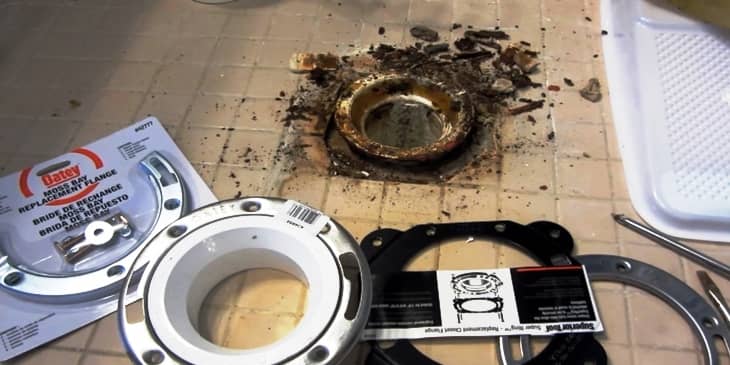It’s a bright and sunny day. You wake up in the morning and answer nature’s call. As you sit on the toilet, you notice that it’s slightly rocking back and forth. To make things worse, it’s even leaking toilet water. Don’t start panicking yet because the solution might be simple.
Uneven toilet flanges commonly cause wobbly toilets and water leakage. Your toilet flange needs to be leveled with the bathroom floor. The disasters mentioned above will come for you if it’s too high.
As I said before, don’t start panicking. Fixing uneven toilet flange is very easy and, most of the time does not even require any fancy tools. Okay, enough talking, let’s get down to business, shall we?
How to Fix Uneven Toilet Flange in a Minute?
Let’s take a look at the tools and materials you will need to fix the uneven toilet flange:
- A hammer.
- PVC cement and primer.
- Electric screwdriver.
- A new toilet flange (if needed).
Step 1 – Removing the Toilet
As the toilet flange is located directly below the toilet seat, the very first thing you’ll have to do is remove the toilet itself. You have to remove the closet bolts holding the toilet seat to do that.
Once you remove those closet bolts, you can lift off the toilet and keep them aside. Now move to the next step.
You may find these article helpful: How to Replace Toilet or Install a New One?
Step 2 – Fixing the Flange
Before fixing the toilet flange, make sure you have covered up the flange hole. Cover it up using a rag or any cloth. This will ensure that nothing falls down the hole. It also blocks out nasty smells so that you can work in peace.
As toilet flanges are unhygienic, I would recommend wearing gloves. Once everything is done, push the toilet flange downwards.
Don’t put too much pressure, or the flange might break. Apply the pressure from the middle. If the flange does not move, it’s time to bring in the big gun.
Step 3 – Hammering the Flange
Just as before, do not put too much pressure on the flange. Start with gently tapping the center of the toilet flange with the hammer.
Increase the force gradually. You should notice that the toilet flange is slowly going down. This would be your green signal that the process is working.
If hammering the flange did not work for you, unfortunately, you must replace it with a new one. And no, you cannot put a new toilet flange over an old one. The old one must be completely removed before installing the new one.
If you are confused that what toilet flange you should buy? Go for Universal Drain 950P Toilet Flange. It is sturdy, easy to install and best value for money.
How to Install a New Toilet Flange?
So, the one-minute method did not work for you? Well, I got another trick up my sleeve. You have to completely remove the old flange, as I’ve said earlier.
Step 1 – Removing the Old Flange
You can try cutting the old one out using drill machines or saws. After removing the old one:
- Place the new one inside the soil pipe to check whether it fits or not.
- If it fits, move to the next step.
- If it doesn’t, try sanding down the soil pipe or removing any leftover old flange pieces.
Step 2 – Installing the New Flange
Start by putting cement primer on the inside of the soil pipe and on the part of the flange that will go inside the soil pipe. Now apply the PVC cement the same way. Immediately put the flange inside the soil pipe and wait for a bit.
After applying the PVC cement glue (yes, you have to glue your flange), make sure to place the flange so that it can line up with the closet bolts.
You can either push the flange down with your hands or use a hammer. The choice is yours. Keep in mind that you have to apply gentle pressure. Make sure it sits flush with the floor. If it’s too high, you’ll face problems again.
Once you have aligned the flange with the toilet closet bolts and pushed the flange down enough, you can screw it in to form a secure hold. Is the toilet flange not level? This should fix that problem.
How Do You Fix a Raised Toilet Flange?
Fixing a raised toilet flange is the same as fixing an uneven toilet flange. All you have to do is follow step three from “how to fix uneven toilet flange,” which is hammering the toilet flange.
Yes, hammering it will take care of everything for you.
Does the Toilet Flange Need to Be Level?
Yes! Your toilet flange absolutely needs to be leveled. Unlevel toilet flanges are known to cause water leakage. You wouldn’t want to touch toilet water, would you?
Unlevel toilet flanges also make the toilet seat wobble or rocky. This wobbliness can sometimes even cause the floor to break.
You may read the article on: How to Tighten a Loose Toilet Seat?
Can You Shim a Toilet Flange?
Yes! You can put shim around your toilet flange to level it, but that should not be your permanent solution. Maybe use that as your temporary solution until you can fix it.
If your floor is the main culprit, you can try putting some shims around the toilet flange to level it.
What Happens If the Toilet Flange Is Too high?
As I said before, toilet flanges need to be leveled. They can’t be too high because that can cause water leakage. It can even leak at the toilet base and flood your bathroom.
It also causes your toilet seat to rock back and forth.
Please read the article on: Fix Your Cast Iron Toilet Flange When It’s Too High
Does Toilet Flange Need to Be Glued?
Every type of toilet PVC part requires glue. If you don’t apply glue on your toilet flange, it will spin freely, which you don’t want. To secure the toilet flange firmly, you need to glue it with PVC cement and primer.
How Do You Offset a Toilet Flange?
If you want to offset a toilet flange, the process is the same as installing a normal flange. Follow my tutorial on “how to install a new toilet flange” above for more details.
Can You Put a New Toilet Flange over an Old One?
No! You cannot put a new toilet flange over an old one. That’s because the new flange won’t fit inside the soil pipe if the old one is still there.
Either you can fix the old one or remove every existence of the old one and replace it with a new toilet flange.
How Far Does a Toilet Flange Need to Be from the Wall?
Remember to keep the flange 12 inches away from the wall to ensure everything works how it should. If you put it too close to the wall, things might not work as expected.
Final Words
The uneven toilet flange is a gateway to many problems. It does not stay limited to only water leakage and rocking back and forth. Also, it can cause fungal outbreaks beneath your toilet.
It is completely natural for you to call the plumber for fixing uneven toilet flange, but my step-by-step guide will save both time and money.
Doing it yourself will also sharpen your plumbing skills so that you can fix various other toilet-related problems. The decision is up to you.

